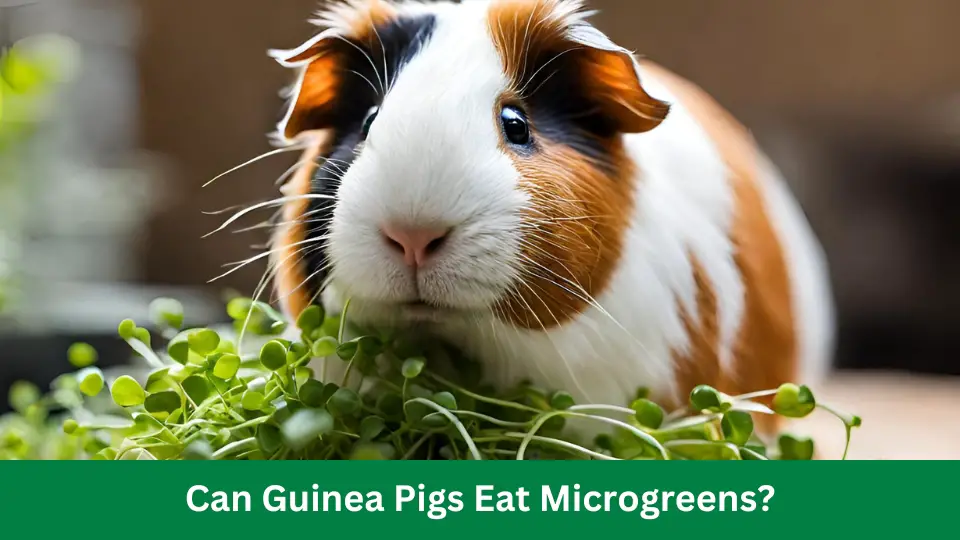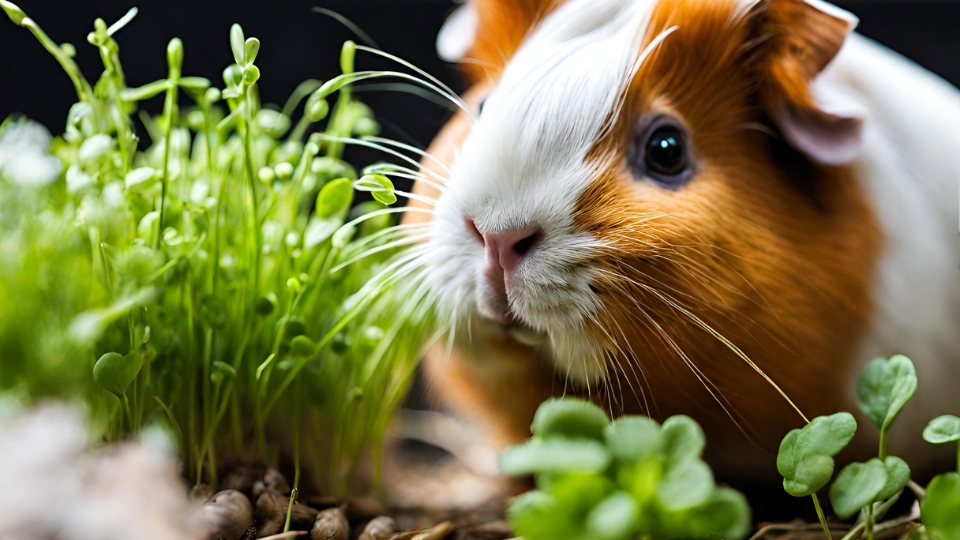
Can Guinea Pigs Eat Microgreens
Guinea pigs can eat microgreens in moderation. These greens provide essential nutrients for their health.
Microgreens, the young seedlings of vegetables and herbs, are a powerhouse of vitamins and minerals. This makes them a fantastic addition to a guinea pig’s diet. They’re not only packed with essential nutrients like Vitamin C, crucial for guinea pigs since they can’t produce it themselves, but they are also low in calories and high in antioxidants.
Offering a variety of microgreens to your guinea pig can contribute to a balanced and vibrant diet. Remember that any dietary addition should be introduced slowly to prevent digestive issues. Always ensure that the microgreens you feed your pet are fresh, clean, and free from pesticides that could harm their delicate systems.
Unpacking The Guinea Pig Diet
Guinea pigs charm us with their playful antics and endearing personalities. But behind those bright eyes and furry coats are unique dietary needs essential for their well-being. An owner’s guide to feeding these furry friends involves more than just a handful of pellets. With the right knowledge, every meal becomes a step towards vibrant health.
Let’s explore the versatility of the guinea pig diet and how microgreens fit into their nutritional tapestry.

Understanding Guinea Pig Nutritional Needs
Guinea pigs require a delicate balance of vitamins, minerals, and fiber for optimal health. Unlike some pets, they cannot produce vitamin C, making it critical to their diets. They thrive on high-fiber foods, which aid digestion and dental health. Here’s a quick rundown of their dietary essentials:
- Vitamin C: Crucial for preventing scurvy
- Fiber: Necessary for digestive health
- Low Fat: Important to avoid obesity
- Protein: Supports growth and repair
The Role Of Fresh Greens In A Guinea Pig’s Diet
Fresh greens represent more than a tasty treat; they’re a cornerstone of a guinea pig’s daily intake. They supply essential nutrients that keep guinea pigs healthy and active. Including various greens ensures a range of vitamins and minerals are available. Microgreens, as a fresh option, could be an interesting addition. Benefits include:
| Green Type | Benefits |
|---|---|
| Microgreens | High in nutrients, it enhances diet variety |
Yet, not all greens are created equal. Some could upset the delicate balance of their diet. It’s crucial to gradually introduce new foods like microgreens and observe changes in your guinea pig’s health or behavior.
Microgreens 101: A Superfood Snapshot
Welcome to a tiny world of nutrition – microgreens! Often spotted garnishing gourmet dishes, these miniature greens pack a punch well above their weight. Perfect for health enthusiasts and flavor-seekers alike. Let’s uncover the secrets of these tiny wonders and see if they’re a fit for our furry friends, the guinea pigs.
Defining Microgreens: What Are They?
Microgreens are young vegetable greens. They appear just after the sprout stage. Despite their size, they’re mighty in flavor and nutrition. Common types include arugula, kale, radish, and basil. Their use spans home kitchens to high-end restaurants, delivering a vibrant splash of color and nutrients.
Nutritional Profile: The Powerhouse Of Vitamins And Minerals
Microgreens are nutritional titans. They offer vitamins A, C, E, and K. They are rich in antioxidants and minerals like calcium and potassium. Here’s a snapshot of what these greens bring to the table:
| Vitamin/Mineral | Benefits |
|---|---|
| Vitamin A | Good for vision and the immune system |
| Vitamin C | Helps with the repair and growth of all body tissues |
| Vitamin E | It acts as an antioxidant to protect cells from damage |
| Vitamin K | Necessary for healthy bones and blood clotting |
| Calcium | Essential for bone and teeth health |
| Potassium | Regulates fluid balance, muscle contractions, and nerve signals |
Can Guinea Pigs Eat Microgreens? The Safe Greens List
Gentle nibblers and adorable pets, guinea pigs always hunt for fresh treats. Yet, not all fresh foods are safe, stirring interest in microgreens. This tiny, nutrient-packed vegetation could spice up your guinea pig’s diet, but which ones are safe?

Let’s explore the magic of microgreens for your furry friends.
Identifying Guinea Pig-safe Microgreens
Guinea pigs savor a variety of greens. But it’s crucial to know which ones are safe. Here’s a quick list of guinea pig-friendly microgreens:
- Kale – Loaded with vitamins, but in moderation.
- Spinach – A good source of Vitamin A, yet high in oxalates.
- Arugula – Offers a peppery flavor that piggies love.
- Radicchio – Adds color and flavor to their meal.
- Lettuce – Go for romaine or butter; skip iceberg.
Note: Always introduce new greens slowly and watch for digestion issues.
The Benefits Of Feeding Microgreens To Guinea Pigs
Munching on microgreens tickles their taste buds and boosts their health. These tiny plants are powerhouses of nutrients. Here’s how microgreens benefit your pet:
| Microgreen | Benefits |
|---|---|
| Kale | Rich in vitamins C, K, and calcium. |
| Spinach | Full of iron and potassium. |
| Arugula | Great source of folic acid. |
| Radicchio | High in antioxidants. |
| Lettuce | Hydrating and full of fiber. |
Feeding a variety ensures balanced nutrition. Always serve in small portions to prevent digestive problems.
Serving Microgreens To Your Guinea Pig: Best Practices
Guinea pigs love a variety of greens in their diet, and microgreens are a nutritious option you can offer them. These young vegetable greens are packed with vitamins and help keep your pet healthy. Yet, serving them requires certain best practices to ensure your guinea pig’s safety and enjoyment.

How To Introduce Microgreens To Your Pet’s Diet
Introducing new foods to your guinea pig must be gradual. Here’s the best way:
- Start small by offering a tiny amount.
- Wait and watch for any allergic reactions.
- Slowly increase the portion size if they respond well.
- Always mix with their regular food to ease the transition.
Portion Control: How Much And How Often
Microgreens are potent with nutrients, so they should only be a small part of your guinea pig’s diet
| Type of Microgreen | Serving Size | Frequency |
|---|---|---|
| Kale | 1-2 leaves | Twice a week |
| Broccoli | A pinch | Thrice a week |
| Arugula | 1-2 leaves | Once a week |
Keep servings small to prevent digestive issues. Overfeeding can lead to health problems.
Finding the right balance for your furry friend is key. Always provide fresh, clean water with their microgreens.
Potential Risks And Considerations
Pet owners must be cautious while guinea pigs enjoy a good nibble on fresh greens and microgreens. Unexpected health issues could stem from these tiny plants. It’s essential to consider the potential risks and take steps to minimize them.
Below, we delve into two critical considerations: pesticides, contaminants, and digestive issues that can affect your furry friend.
Watch Out For Pesticides And Contaminants
Microgreens might be small, but they can carry unwanted chemicals. Pesticides used in farming can pose health risks to guinea pigs. Thus, it’s vital to choose organic microgreens that are certified pesticide-free. Clean them thoroughly under running water before serving.
- Choose Organic: Ensure microgreens are free from harmful chemicals.
- Wash Thoroughly: Rinse well to remove any dirt or potential residue.
- Introduce Slowly: Start with small amounts to ensure they suit your pet.
Understanding The Risk Of Digestive Issues
Guinea pigs have sensitive digestive systems. New foods can disrupt their gut balance. Microgreens are nutrient-rich but can be harsh on tiny tummies if not introduced properly. Start with a small portion and observe for any signs of digestive discomfort.
| Signal | Action |
|---|---|
| Change in stool | Reduce the amount or stop feeding |
| Bloating | Consult a vet immediately |
| Lethargy | Assess diet and seek vet advice |
Remember, gradual changes in diet help prevent digestive upset. Monitor your guinea pig’s health as you introduce new microgreens. Prioritizing safety ensures your pet remains happy and healthy.
Beyond The Bowl: Cultivating Microgreens At Home
Guinea pigs crave fresh, nutritious food to thrive, and nothing tops the freshness of greens harvested straight from your habitat. Cultivating microgreens at home elevates the typical guinea pig diet with a splash of variety and a burst of nutrients.
It is a simple, quick process that can also serve as a family-friendly activity, rewarding you with safe and healthy greens for your furry friend.

Diy Microgreens: A How-to Guide For Pet Owners
Starting a microgreen garden requires minimal space and tools. Here’s a quick guide:
- Select a shallow tray.
- Fill it with quality soil or a soil substitute.
- Sprinkle seeds (like spinach or radish) evenly across the surface.
- Lightly cover them with an additional soil layer.
- Water gently, and keep the soil moist, not wet.
- Place in a spot with ample sunlight or use a grow light.
- Harvest your microgreens when they’re 3-4 inches tall.
Caring for your microgreens ensures safe, chemical-free snacks for your guinea pig.
The Advantages Of Home-grown Microgreens
Why grow microgreens at home? Consider the benefits:
- Highly nutritious: They’re packed with vitamins and minerals.
- Economical: Save money over store-bought options.
- Eco-friendly: Reduce the carbon footprint of your pet’s diet.
- Guaranteed fresh: You know precisely when they were harvested.
- Stress-relieving: Gardening is a peaceful, rewarding activity.
Growing microgreens introduce wholesome variety into your guinea pig’s routine.
Frequently Asked Questions Of Can Guinea Pigs Eat Microgreens
Are Microgreens Safe For Pets?
Microgreens are generally safe for pets, but some, like onion or garlic greens, can be toxic. Always check individual microgreen safety before sharing with pets.
What Greens Can Guinea Pigs Not Eat?
Guinea pigs cannot eat iceberg lettuce, potatoes, rhubarb, or avocado as they can harm their health. Always avoid these greens to ensure their well-being.
What Animals Can Eat Microgreens?
Many animals, including rabbits, guinea pigs, chickens, and turtles, enjoy eating microgreens as part of their diet. These nutrient-rich greens are also safe for most household pets.
Conclusion
To sum up, guinea pigs can safely enjoy microgreens as a nutritious snack. These leafy wonders are packed with valuable nutrients. Just remember to introduce them slowly and monitor your pet’s reaction. A balanced diet is key for your guinea pig’s health, making microgreens a great choice to enrich their meals.
Always consult with your vet for the best dietary advice.
Video Source: https://www.youtube.com/watch?v=jDCFVw_E_-o


